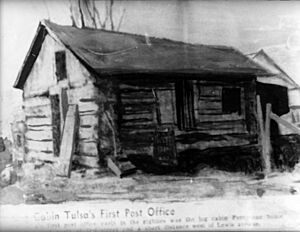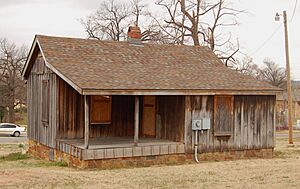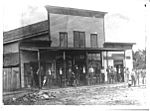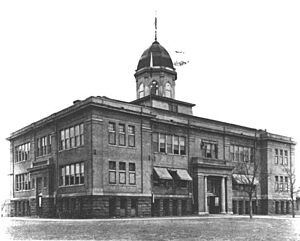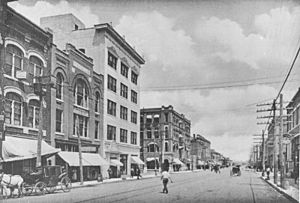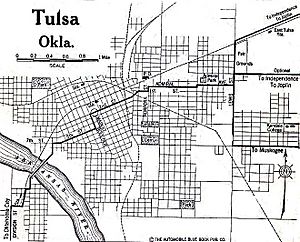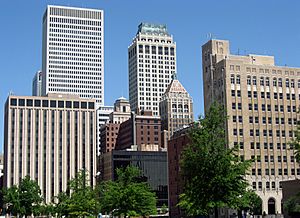History of Tulsa, Oklahoma facts for kids
Tulsa is the second-largest city in the state of Oklahoma. It is also the 45th-most populated city in the United States.
For most of the 1900s, Tulsa was known as the "Oil Capital of the World." It played a huge role in the American oil industry.
Contents
- Early Days: 1830–1882
- Railroads Arrive: 1882–1901
- Oil Boom Begins: 1901–1907
- Oklahoma Becomes a State: 1907–1915
- Second Oil Boom: 1915–1930
- The Roaring Twenties: 1920–1930
- The Great Depression: 1930–1940
- "America's Most Beautiful City": 1940–1960
- City Changes: 1960–1980
- Oil Bust and Recovery: 1982–Present
- See also
Early Days: 1830–1882
The area that became Tulsa was once part of Indian Territory. This land was set aside for Native American tribes. These tribes, including the Choctaw, Cherokee, Muscogee (Creek), Chickasaw, and Seminole peoples, were called the Five Civilized Tribes. They were forced to move here after the Indian Removal Act of 1830. They had to give up their lands east of the Mississippi River to the U.S. government. In return, they were promised land and independence in Indian Territory.
Each large tribe received its own land. They formed their own governments and worked to rebuild their lives. Many became farmers, trappers, and ranchers. Most of modern Tulsa is in the Muscogee Nation. Some parts are in the Cherokee Nation and Osage Nation.
First Settlers: Muscogee Creeks
The first people to settle what is now Tulsa were the Lochapoka (Turtle Clan) Muscogee (Creek) tribe. They arrived between 1828 and 1836. They were forced from their home in Alabama. Their chief, Achee Yahola, led them to a new home near what is now Cheyenne Avenue and 18th Street.
Under a big oak tree, now called the Creek Council Oak Tree, they lit their ceremonial fire again. The Lochapoka named their new settlement "Tulasi." This means "old town" in their language. They used this spot for ceremonies and games until 1896. The area around the tree became "Creek Nation Council Oak Park" in 1929.
In 1832, the writer Washington Irving visited the area. He wrote about it in his book A Tour on the Prairies. He camped near the Arkansas River, a few miles south of today's Tulsa.
In 1846, Lewis Perryman built a log cabin trading post. It was near what is now 33rd Street and South Rockford Avenue. Perryman, who was part Creek, ran a business there until the Civil War. After the war, the area grew. In 1879, the first post office opened on a ranch belonging to Josiah Chouteau Perryman, one of Lewis's sons. Josiah became Tulsa's first postmaster.
The post office was first in a log cabin. Later, it moved to George Perryman's ranch house. By then, the area was called 'Tulsey Town.' It was a trading post and cattle town. Lewis Perryman had many children who became important in Tulsa's early history.
The first Christian missionary to the Lochapoka area was J. Ross Ramsey. He preached at Lewis Perryman's home in 1856.
A Methodist minister, Rev. Sylvester Morris, built a house in the early 1880s. This house is now in Tulsa's Owen Park. It is the oldest surviving house in Tulsa.
Civil War Times
During the American Civil War, the U.S. government was divided. Some groups in Indian Territory supported the Confederacy.
After some Creeks signed a treaty with the Confederacy, Principal Chief Opothle Yahola realized that those who disagreed were in danger. These Creeks, along with some Seminoles and Union supporters, gathered their families and belongings. They moved to a temporary camp. When they learned Confederate forces were coming, they fled towards a Federal fort in Kansas.
The Confederates caught up with them on November 19, 1860. A fight happened, but it got too dark to continue. The Unionists slipped away during the night. Opothleyahola led his group toward Tulsey Town. The Lochapokas helped them and joined their journey. The Confederates kept chasing them. On December 8, many Cherokee soldiers decided to join the Unionists. They left the Confederate side. The fighting continued, but the Unionists kept escaping.
Railroads Arrive: 1882–1901
In August 1882, Tulsa had about 200 people. The Atlantic and Pacific Railroad (later the Frisco) extended its line to Tulsa. This helped the cattle business, which was the city's first big industry.
Josiah Perryman and Has Reede opened a store. Perryman moved the post office to this store for better mail service. He was postmaster until 1885.
The Hall brothers, James M. and Harry C., chose where the railroad would stop. They first set up a tent store in Cherokee Nation. But when they found fewer rules for white merchants in Creek Nation, they moved their store a few miles west. James M. Hall is often called the 'Father of Tulsa.' He laid out Tulsa's first streets, built its first permanent store, and helped start its first church, school, and government.
In March 1883, T. J. (Jeff) Archer, a mixed-blood Cherokee, opened a general store. He died in 1905 when a customer's gun caused an explosion in his store. The city named the street next to the Frisco track after him.
In 1884, Rev. W. P. Haworth, a Presbyterian missionary, came to Tulsa. He built a church building. Mrs. Haworth and another woman started teaching school in their homes until the building was ready. The first church opened on October 5, 1885. Haworth left Tulsa in 1888 after being attacked.
The Presbyterian Church started the Presbyterian Mission Day School in 1884. It was a one-story building that soon got a second story. This school ran until 1889. After Tulsa became a city in 1898, the city government took over the school. It became the first public school.
Throughout the 1800s, Native American tribes had to accept more treaties. These treaties made their lands smaller. White settlers kept moving in. By 1898, Tulsa had 1,100 people. The city was officially formed in 1899. By 1900, the population was 1,390.
The first newspaper in Tulsa, The Tulsa Review, started in 1893. Another paper, the New Era, began in 1895. It later became the Tulsa World in 1905.
The first telephone system in Tulsa started in 1899. Robert H. Hall connected 80 homes. He sold his system in 1903. By 1904, Pioneer Telephone and Telegraph Company was the only phone provider in Tulsa.
In 1900, Rev. C. W. Kerr became Tulsa's first permanent Christian minister. He started the First Presbyterian Church of Tulsa. He was important in Tulsa's growth.
Oil Boom Begins: 1901–1907
Tulsa quickly grew from a small frontier town into a boomtown. This happened after oil was found in 1901 at Red Fork, a small town southwest of Tulsa. Oil explorers and investors rushed into the city. Tulsa began to take shape. In 1901, the city hired people to survey and lay out streets. New neighborhoods were built.
A smallpox outbreak hit Tulsa in 1900. Dr. Fred S. Clinton set up the area's first hospital in a small cottage. It closed after the outbreak ended. Tulsa's next hospital opened in 1906. A nursing school started there, and its first class graduated in 1908.
Tulsa had natural springs, but they weren't enough for a growing city. In 1904, Tulsa built a pumping plant to bring water from the Arkansas River. But this water was not good for drinking. It had a lot of silt, salt, and gypsum. Most people bought drinking water in large containers.
In 1905, the Glenn Pool oil field was discovered. This find brought a huge amount of oil. It made Tulsans build storage tanks and pipelines for the extra oil. This discovery helped Tulsa become a leader in the oil and gas business. Many early oil companies, like Texaco, made Tulsa their home.
Tulsa built its first two public schools in 1905. More schools were built quickly in 1906. In December 1907, the Tulsa Board of Education took control of the public schools. Tulsa High School opened in 1906. It was a three-story brick building with a dome.
Oklahoma Becomes a State: 1907–1915
Kendall College, a Presbyterian school, moved to Tulsa from Muskogee in 1907. This school later became the University of Tulsa. It was the start of higher education in the city.
When Oklahoma became a state in 1907, Tulsa had 7,298 people. By 1910, the population had grown to 18,182.
The first oil refinery in Tulsa was built by Texaco in 1910 in West Tulsa. Texaco ran it until 1983. The second refinery was built in 1913 by Joshua Cosden. It later became Sunray D-X and Sunoco. In 2009, Holly Corporation bought both refineries.
Tall buildings started appearing downtown. The Tulsa Hotel and the Brady Hotel annex were built around 1910. The 16-story Cosden Building, built in 1918, was Tulsa's first skyscraper. It is now part of the Mid-Continent Tower.
In 1917, the Federal Building was built. It held the main post office and courtrooms. It was made much bigger in 1933.
Second Oil Boom: 1915–1930
By 1920, Tulsa's population exploded to over 72,000. Many new people came from states like Pennsylvania and Ohio. More oil discoveries between 1915 and 1930 truly made Tulsa the "Oil Capital of the World."
Rich oilmen like Waite Phillips, William G. Skelly, and J. Paul Getty built grand homes and modern offices. Many buildings from this time have the beautiful Art Deco style. Cultural groups like a Symphony and Ballet companies were started. Theatre Tulsa, the oldest community theater west of the Mississippi River, was also founded. In 1932, Waite Phillips gave his amazing mansion, "Philbrook", to the city to be an art museum.
The Roaring Twenties: 1920–1930
Another community that grew in Tulsa during the early oil booms was Greenwood. It was the largest and wealthiest African American community in Oklahoma. It was known across the country as "Black Wall Street." Greenwood was a lively place for jazz and blues music in the 1920s.
Tulsa Race Massacre: 1921
The Tulsa Race Massacre of 1921 was a terrible event. From May 31 to June 1, 1921, white rioters attacked the Greenwood neighborhood. More than 39 people were officially reported killed, but many believe the number was much higher, possibly over 300. Over 800 people were hurt, and about 10,000 lost their homes.
Many homes and businesses in Greenwood were destroyed by fire. The damage was estimated at $1.8 million, which would be nearly $17 million today. There are reports that white attackers used private planes to drop things and shoot at people. This attack destroyed much of the success of Black Wall Street. While some homes were rebuilt, many business buildings remained burnt and unsafe for over 60 years.
Spavinaw Water Project
Tulsa's first water system in 1904 used water from the Arkansas River, but it was not good for drinking. Wells also did not provide enough good water.
In 1922, Tulsa voters approved money to build the Spavinaw Dam. The dam was finished in 1924. It created Lake Spavinaw, which was fed by a stream from the Ozark Mountains. A pipeline was built to bring this water to Lake Yahola in Tulsa's Mohawk Park. This pipeline was the longest of its kind in the U.S. at the time.
In 1923, the Arkansas River flooded the city's waterworks, so they were moved to Mohawk Park. The new water system started working in 1924. In 1929, the Mohawk Water Treating Plant was finished. This has been Tulsa's main source of drinking water ever since. A second pipeline was added in 1954, doubling the water supply. In 1952, Lake Eucha was created to store more water and help Lake Spavinaw.
City Growth in the 1920s
Tulsa grew by adding nearby communities. In 1927, it added Red Fork. In 1928, it added Carbondale. Both are now neighborhoods in West Tulsa.
The Great Depression: 1930–1940
In 1930, Tulsa's population was over 140,000, almost double what it was in 1920. The Tulsa Union Depot, finished in 1931, brought all passenger train traffic to one place. Train passenger service stopped in 1967. The building was later turned into offices in 1982.
The Philcade Building, ordered by Waite Phillips, was finished in 1931. It was the last tall Art Deco office building built downtown. A new terminal building for the Tulsa Municipal Airport was completed in 1932.
The Great Depression slowed Tulsa's population growth. The population barely changed between 1930 and 1940. However, Tulsa's economy did not suffer as much as other parts of the country. People with gardens did better during this time. Small grocery stores like Warehouse Market also thrived.
"America's Most Beautiful City": 1940–1960
Tulsa added the town of Dawson in 1949, gaining 3,500 residents.
The mid-1900s brought continued good times for most people. The money from the early oil industry also helped Tulsa become a leader in the aviation industry. During World War II, the Spartan School of Aeronautics trained many pilots. In 1942, Douglas Aircraft built a large plant to build bombers. After the war, Tulsa became an important place for airplane maintenance.
In 1957, a magazine called Tulsa "America's Most Beautiful City." This was because of its parks, oil mansions, churches, museums, and rose gardens.
On July 10, 1950, the United States Junior Chamber opened its new headquarters in Tulsa.
In 1957, a new 1957 Plymouth Belvedere car, called Miss Belvedere, was buried underground near the courthouse. This was to celebrate Oklahoma's 50th birthday. A time capsule was buried with it. The car was supposed to be dug up in 2007 for Oklahoma's 100th birthday. When it was dug up, water had leaked into the tomb, and the car was very rusty. The time capsule, however, was fine.
During the 1950s, Tulsa added more than 25 square miles to its area.
City Changes: 1960–1980
Mayor James Maxwell, elected in 1958, led several building projects in the 1960s. Voters approved money to build a new civic center. The International Petroleum Exposition building was also built at the Tulsa fairgrounds.
The Tulsa Urban Renewal Authority (TURA) started in 1959. Its goal was to improve distressed areas. One of its first projects was public housing. TURA was renamed the Tulsa Development Authority (TDA) in 1976. TDA buys unwanted properties to encourage new development.
One big urban renewal project was the Williams Center. The most famous part of this project is the BOK Tower. This project cleared several blocks downtown, tearing down many of the city's oldest buildings. Only one building from before 1910, the Pierce Block, remains downtown.
Oil Bust and Recovery: 1982–Present
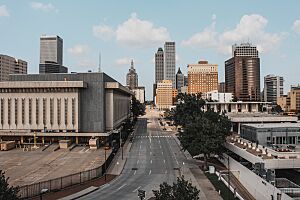
After the "Oil Bust" of 1982-84, Tulsa lost its title as "Oil Capital of the World" to Houston. City leaders worked to make Tulsa's economy more diverse. They brought in factory jobs, Internet and telecommunications companies in the 1990s. The aviation industry also grew. Customer service and reservations call centers became important to the local economy. The supply of natural gas also helped with recovery.
Centennial Time Capsule
In 1998, to celebrate Tulsa's first 100 years as a city, a Plymouth Prowler car was sealed in a time capsule. It was buried in Centennial Park. The city plans to open it in 2048. This time, the car was put in a special plastic box inside an above-ground concrete vault. Other items were added to the time capsule.
21st-Century Growth
In the early 2000s, Tulsa's economy faced a downturn, like the rest of the country. But recovery began around 2004. By 2006, the number of jobs in Tulsa was higher than before the downturn. Tulsa remained an attractive place for businesses to expand, partly because of low housing prices.
City leaders started the "Vision 2025" program in 2003 to improve Tulsa's buildings and services. The main project of Vision 2025 was building the BOK Center downtown. This arena, designed by architect Cesar Pelli, is home to the city's hockey team. It also hosts concerts and conventions. Construction started in 2005 and finished in 2009.
In 2007, Tulsa agreed to a plan to develop the Arkansas River area. The plan includes more low-water dams to keep water in the river. It also calls for better recreation areas, pedestrian crossings, and easier access to the river banks.
In 2014, construction began on "A Gathering Place for Tulsa." This is a big expansion and renovation of the Tulsa River Parks area. It is funded by private donations, including a large amount from the George Kaiser Family Foundation.
The Kaiser Family Foundation also funded and runs the Guthrie Green. This is an urban park and entertainment space in the Tulsa Arts District. It hosts free events, concerts, movies, and fitness classes. Guthrie Green opened in September 2012. It is near the Woody Guthrie Center, a museum about the Oklahoma native, and the Philbrook Museum's downtown art collections.
The 2017 Tulsa tornado happened on August 5–6, 2017, near Tulsa, Oklahoma.
See also
- Timeline of Tulsa, Oklahoma
- Flooding and flood control in Tulsa




